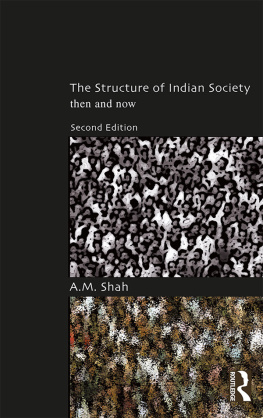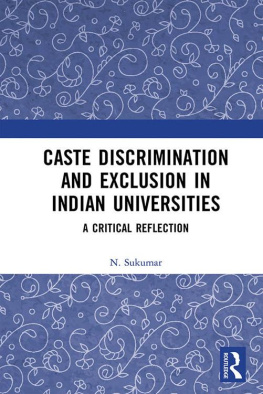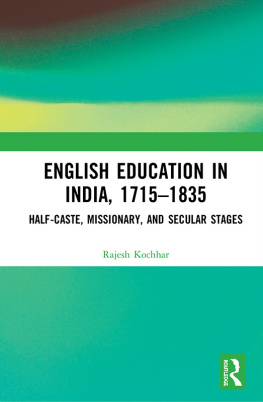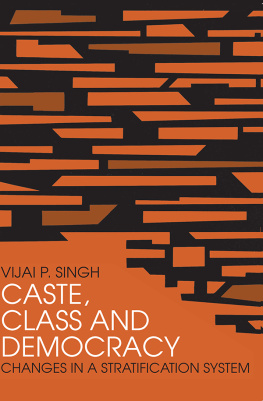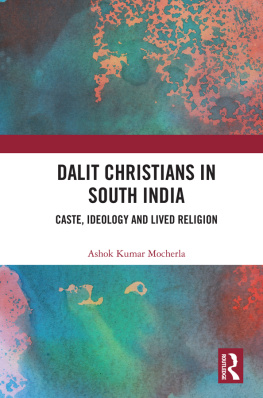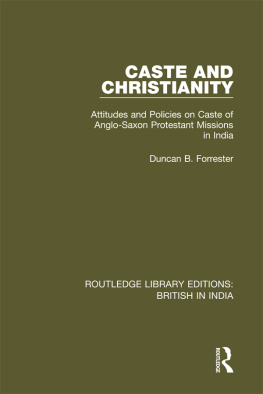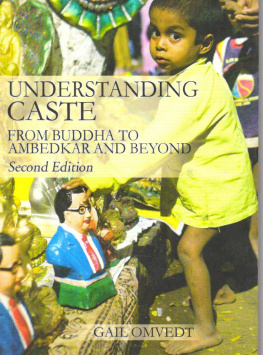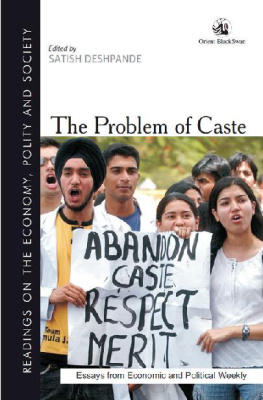The Structure of Indian Society
This book explores the structural features of Indian society, such as caste, tribe, sect, ruralurban relations, sanskritization and untouchability. Based on a wealth of field research as well as archival material, the book
- Interrogates the prevailing thinking in Indian sociology on these structures;
- Studies Indian society from contemporary as well as historical perspectives;
- Analyses caste divisions vis--vis caste hierarchy;
- Critically examines the public policies regarding caste-less society, reservations for Backward Classes, and the caste census.
This second edition, with four new chapters, will be a key text for students and scholars of sociology, social anthropology, political science, modern history, development studies and South Asian studies.
A.M. Shah is former Professor of Sociology at the Delhi School of Economics, University of Delhi, and National Fellow of the Indian Council of Social Science Research, New Delhi, India. Felicitated with the Lifetime Achievement Award by the Indian Sociological Society in 2009, he has also been the recipient of the Swami Pranavananda Award from the University Grants Commission, and the Distinguished Service Award from the University of Delhi. He has held fellowships at the University of Chicago; the Centre for Advanced Study in the Behavioural Sciences, Stanford; the Institute of Development Studies, Sussex, UK; and the University of New England, Australia. He has authored and edited many books, including The Household Dimension of the Family in India (1973); Division and Hierarchy (co-authored with I.P. Desai (1988); The Family in India: Critical Essays (1998); Exploring Indias Rural Past (2002); The Writings of A.M. Shah: the Household and Family in India (an omnibus, 2014); and Sociology and History (2017). He has contributed extensively to academic journals and symposia, including ten articles in Gujarati. He has been honoured with a festschrift, Understanding Indian Society: Past and Present (2010), edited by B.S. Baviskar and Tulsi Patel.
This book forces its reader to revisit the Indian society as it exists today [it] comes as a fresh guide for young sociologists in understanding the Indian social structure in a refreshing and befitting academic framework.
Rajesh Gill,Sociological Bulletin
Shahs articles open up some less trodden paths in the study of India.
Sirpa Tenhunen,Journal of the Royal Anthropological Institute
Second edition published 2019
by Routledge
2 Park Square, Milton Park, Abingdon, Oxon, OX14 4RN
and by Routledge
52 Vanderbilt Avenue, New York, NY 10017
Routledge is an imprint of the Taylor & Francis Group, an informa business
2019 A.M. Shah
The right of A.M. Shah to be identified as author of this work has been asserted by him in accordance with sections 77 and 78 of the Copyright, Designs and Patents Act 1988.
All rights reserved. No part of this book may be reprinted or reproduced or utilised in any form or by any electronic, mechanical, or other means, now known or hereafter invented, including photocopying and recording, or in any information storage or retrieval system, without permission in writing from the publishers.
Trademark notice: Product or corporate names may be trademarks or registered trademarks, and are used only for identification and explanation without intent to infringe.
First edition published by Routledge 2010
British Library Cataloguing-in-Publication Data
A catalogue record for this book is available from the British Library
Library of Congress Cataloging-in-Publication Data
Names: Shah, A.M., 1931 author.
Title: The structure of Indian society : then and now / A.M. Shah.
Description: Second edition. | Abingdon, Oxon ; New York, NY :
Routledge, 2019. | Includes bibliographical references and index.
Identifiers: LCCN 2018058195 (print) | LCCN 2019002872 (ebook) |
ISBN 9780429401268 | ISBN 9781138351288 (hardback) |
ISBN 9780367193195 (pbk.)
Subjects: LCSH: CasteIndia. | Class consciousnessIndia. |
Social classesIndia.
Classification: LCC HT720 (ebook) | LCC HT720 .S379 2019 (print) |
DDC 305.5/1220954dc23
LC record available at https://lccn.loc.gov/2018058195
ISBN: 978-1-138-35128-8 (hbk)
ISBN: 978-0-367-19319-5 (pbk)
ISBN: 978-0-429-40126-8 (ebk)
Typeset in Bembo
by Apex CoVantage, LLC
In the second edition of this book I have included four essays written since the publication of the first edition. One of them (), The Mirage of a Casteless Society in India, deals with the goal of creating a casteless society in India that the English-educated new intelligentsia developed since the beginning of Indias engagement with the West in the early 19th century. The expression of this goal, passing through various stages, reached its climax when in 1950 the Constitution of democratic independent India declared discrimination on the basis of caste as unlawful. A number of social scientists also believed that caste would wither away under the impact of industrialization, urbanization, and modernization. I have tried to show how the achievement of this goal is getting increasingly frustrated, on the one hand, by innovative activities organized by caste groups to retain their unity and integrity, and on the other hand, by the failure of political as well as judicial leadership to take appropriate legal steps to control the power of caste groups. In recent years, the country has witnessed in different states massive demonstrations by castes to press for getting their demands accepted. Similarly, in all elections, all political parties and their candidates, including even those aspiring to be prime ministers, have appealed to voters castes for votes. Achievement of the goal of a casteless society has thus become a mirage.
I had discussed in discusses this training programme and its implications. Remarkably, here the secular state is supporting a priestly caste of high social status on the one hand and spreading Sanskritic Hinduism among the Dalits on the other hand, under the pretext of supporting a constitutionally recognized Scheduled Caste.
first discusses the consequences of urban growth for villages. This requires us to understand that the village as a geographical entity has two components. There is, firstly, the village site as residential settlement, where dwellings and various public structures such as temple, mosque, primary school, village accountants office, and so on are located. Secondly, there is open territory all around the village site, comprising agricultural fields, pasture land, waste land, cart tracks, water tank and ponds, crematorium, burial ground, and so forth. When the municipal boundaries of a city are expanded, the adjoining villages each with the two components are included within these boundaries. While agricultural and other land gets covered over with cement-concrete buildings of various kinds, the village settlement remains as an enclave, with significant consequences for life both in the city and the village enclave.
A different kind of transformation takes place in some villages away from the city. When a village becomes prosperous, changes take place in the lifestyle of its people, such that it attracts a number of traders, artisans, craftsmen and servicemen from the neighbouring urban centres. A number of urban style institutions also get located here. In this process the non-agricultural component of the population might grow so large that the village becomes a small town. This process negates the usual definition of urbanization as migration of rural population to urban centres.

